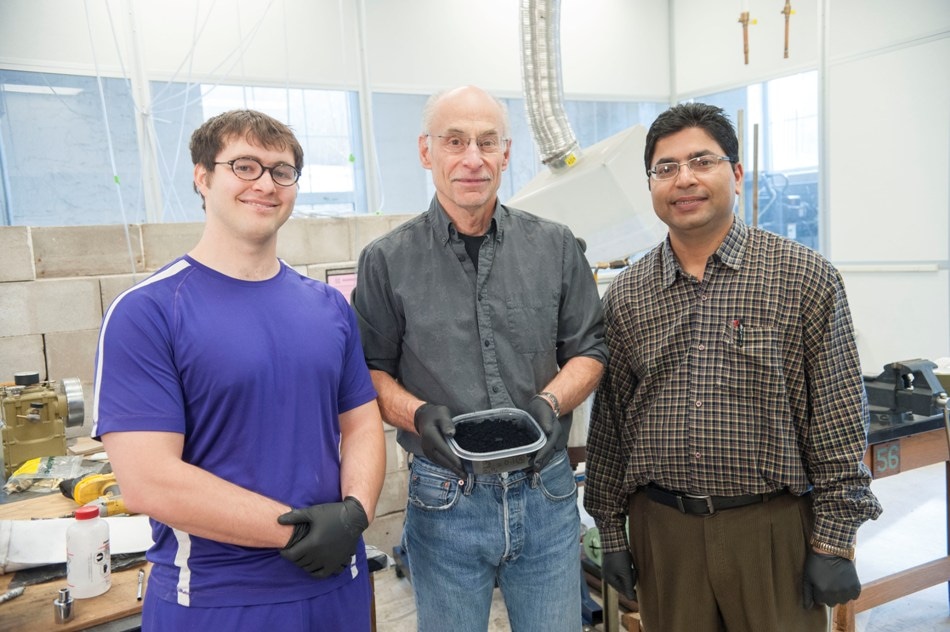Jan 27 2017
 From left: Kansas State University researchers Justin Wright, doctoral student in physics, Camp Hill, Pennsylvania; Chris Sorensen, Cortelyou-Rust university distinguished professor of physics; and Arjun Nepal, postdoctoral researcher and instructor of physics, hold a container of graphene. Sorensen and Nepal have patented a method to create graphene through a controlled detonation. (credit: Kansas State University)
From left: Kansas State University researchers Justin Wright, doctoral student in physics, Camp Hill, Pennsylvania; Chris Sorensen, Cortelyou-Rust university distinguished professor of physics; and Arjun Nepal, postdoctoral researcher and instructor of physics, hold a container of graphene. Sorensen and Nepal have patented a method to create graphene through a controlled detonation. (credit: Kansas State University)
A research team from Kansas State University have discovered a new technique for mass-producing graphene, but without the use of catalysts, chemicals, and expensive machinery. The new technique involved the use of oxygen, hydrocarbon gas, and a spark plug.
Their method is simple: fill a chamber with ethylene or acetylene gas and oxygen. A vehicle spark plug was used to generate a controlled detonation. Then, the synthesized graphene was collected.
Chris Sorensen, distinguished professor of physics at the Cortelyou-Rust University, is the lead inventor of the recently issued patent titled “Process for high-yield production of graphene via detonation of carbon-containing material.” Arjun Nepal, postdoctoral researcher and instructor of physics, and Gajendra Prasad Singh, former visiting scientist, are the other Kansas State University researchers involved in the research.
We have discovered a viable process to make graphene. Our process has many positive properties, from the economic feasibility, the possibility for large-scale production and the lack of nasty chemicals. What might be the best property of all is that the energy required to make a gram of graphene through our process is much less than other processes because all it takes is a single spark.
Chris Sorensen, Professor, Cortelyou-Rust University
Graphene is the world’s thinnest material because it is made of a single atom-thick sheet of carbon atoms that are hexagonally coordinated. From the year 2004, when graphene was first isolated, researchers have discovered that it possesses significant electronic and physical properties, enabling it to be used for various applications such as highly efficient rechargeable batteries or high-quality electronics.
Sorensen’s research team accidentally discovered the method to produce graphene during the course of developing and patenting carbon soot aerosol gels. In order to produce the gels they filled oxygen and acetylene gas in an aluminum chamber with a capacity of 17 liters. According to Sorensen, the researchers generated a detonation in the chamber with a spark plug, which resulted in the formation of soot that resembled “black angel food cake.”
However, further investigation led the researchers to conclude that the aerosol gel was not mere dark angel food cake lookalike, but was actually graphene.
We made graphene by serendipity. We didn’t plan on making graphene. We planned on making the aerosol gel and we got lucky.
Chris Sorensen, Professor, Cortelyou-Rust University
However, when compared to other techniques for producing graphene, Sorensen’s technique was inexpensive, simple, scalable, and efficient for industrial production.
Yet other techniques for producing graphene include “cooking” mineral graphite for a long period of time with chemicals such as sulfuric acid, potassium permanganate, sodium nitrate, or hydrazine at accurately specified temperatures. Supplementary techniques include heating of hydrocarbons up to 1000 °C by adding catalysts.
Apart from being energy intensive, and also high-risk, such methods provide a low yield. In contrast, the technique adopted by Sorensen and his colleagues provides higher yield with minimal energy and without the production of any dangerous chemicals.
“The real charm of our experiment is that we can produce graphene in the quantity of grams rather than milligrams,” stated Nepal.
The research team includes Justin Wright, doctoral student in physics, Camp Hill, Pennsylvania. They are searching for ways to enhance the quality of the produced graphene and to scale the laboratory procedure to an industrial level. They are working to upgrade specific equipment to easily obtain graphene from the chamber just seconds (and not minutes) after the detonation. According to Sorensen, swiftly obtaining the graphene will enhance its quality.
The Kansas State University Research Foundation, a nonprofit corporation accountable for managing activities related to technology transfer at the university, was issued with the patent.
Mass Producing Graphene | K-State News
Arjun Nepal, Kansas State University postdoctoral researcher and instructor of physics, describes a special process of mass-producing graphene